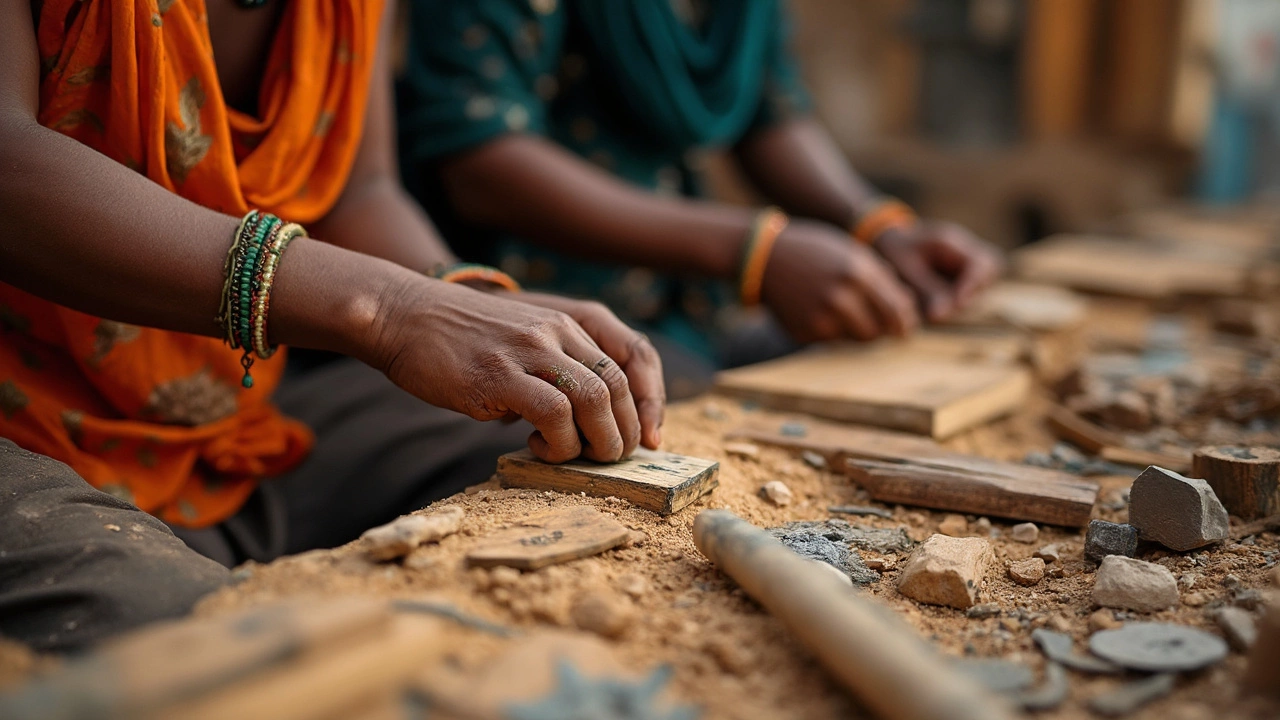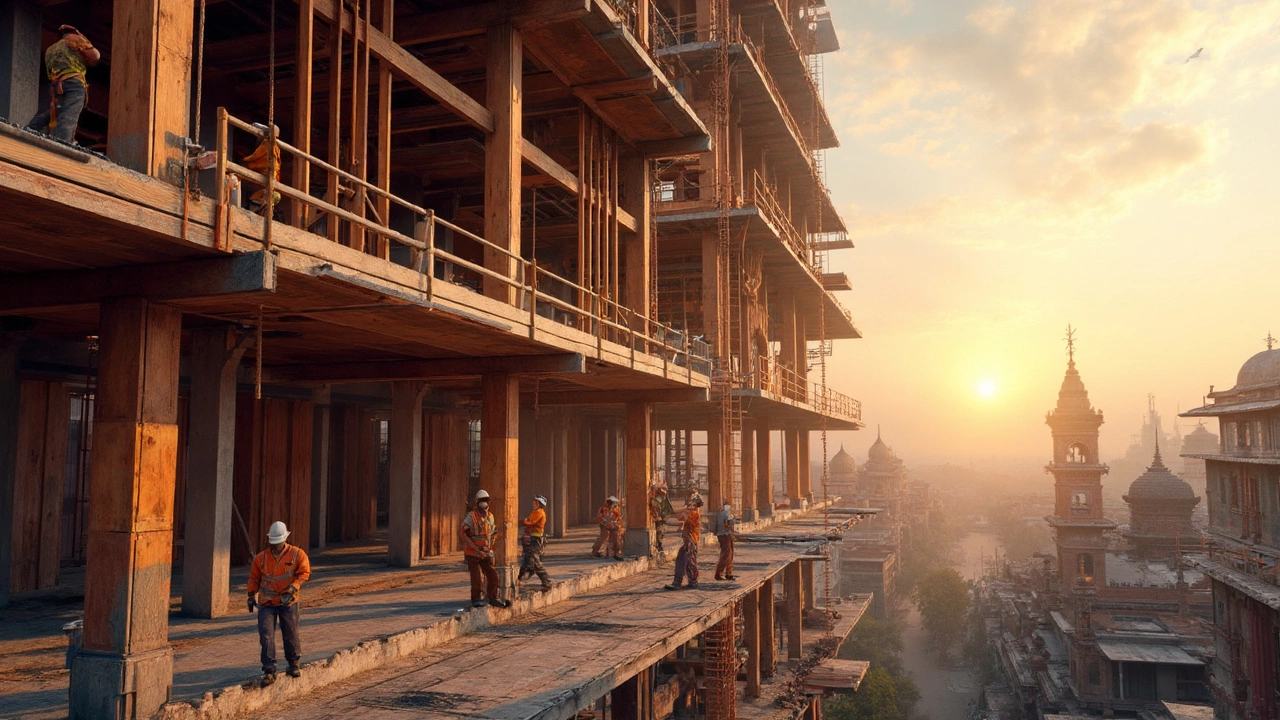Ever wonder what makes up the bones of our homes and the skyscrapers touching the clouds? It all boils down to construction materials—those crucial elements that support, protect, and connect us. From wood and brick to cutting-edge composites, there's a wild world of materials that turn blueprints into reality.
Let’s talk about traditional materials first. Wood, for example, has been a favorite for ages—it's sturdy, workable, and has a natural charm. But it’s not just about trees; we’ve got brick, amazingly durable and synonymous with that classic look. Kinda like jeans—they never go out of style, right?
Of course, the world doesn’t stay still. We’ve got modern marvels like engineered wood and composite materials popping up everywhere. They’re designed to solve some of the limitations we've faced with the old stuff—like a superhero upgrade but for your walls and floors.
- Traditional Materials and Their Roles
- Modern Innovations in Construction
- Choosing the Right Materials
- Impact on Sustainability and Cost
Traditional Materials and Their Roles
Let’s think about what’s been holding up buildings for centuries. The classics like wood, brick, and stone have been vital in construction for a long time, and honestly, they've earned their keep.
Wood: Nature's Versatile Gift
Wood is the go-to material when we talk about a natural, warm feel in constructions. It's been used since, well, forever. You can shape it for doors, frames or just go all out and build log cabins. It’s fairly easy to work with and renewable if sourced responsibly. Did you know? Wood can last over 100 years if maintained well.
Bricks: Solid and Storied
Brick is another old-timer that’s not going anywhere. These bad boys are made from clay or shale and are renowned for being resistant to wear and tear. Houses built with bricks are known to be great at regulating temperature too—warm in winter, cool in summer. Classic brick walls have a reputation for standing up to nasty weather.
Stone: The Heavyweight Champ
When we talk permanence, stone is what you want. Think castles, cathedrals, and pretty much anything meant to last. It requires less maintenance than many other materials because, surprise—it doesn’t rot or get eaten by insects. Certain stones are better suited for construction such as granite and limestone.
Here’s a little nugget of info for those curious about history: Some Egyptian pyramids were built using over two million individual stone blocks! Weighing between 2 to 30 tonnes each, that’s a flex on ancient engineering.
Overall, choosing these traditional materials can often mean your structure is battle-tested against nature and time. But remember, just as with picking the right pair of shoes, maintenance is key to getting that long-lasting vibe.
Modern Innovations in Construction
The construction world today is like a living lab with inventions popping up that redefine how we build. Let's take a peek at some of the wildest breakthroughs that are shaping the future of construction materials.
Engineered Wood
First up, engineered wood. It's a game-changer, crafted from layers of wood bonded together. This stuff is stronger and much more reliable than your regular lumber. Plus, it uses less wood overall, which makes it an eco-friendly option. Imagine all the trees we’re saving with this trick!
Composite Materials
Next, let's chat about composite materials. These are straight-up sci-fi, created by combining two or more materials to get the best properties of each. Think about fiber-reinforced plastics used in bridges and buildings—lightweight yet super strong. It’s like having a diet soda that tastes as good as regular!
Innovative Concrete
Concrete is getting a facelift too. Ultra-high-performance concrete (UHPC) is like concrete on steroids. It’s ductile and has higher tensile strength, meaning structures are safer and last longer. That means fewer repairs and less hassle in the long run.
3D Printing
Did you know we’re actually 3D printing houses now? This isn't science fiction—it's happening. Using 3D printers for construction means we can build faster and cut down costs. It’s perfect for affordable housing emergencies and even in adapting creative architectural designs.
Insulating Materials
Insulation is getting cooler too—no pun intended. Vacuum insulation panels and aerogels provide exceptional thermal insulation in a surprisingly thin profile. If you've ever squeezed styrofoam for its insulating properties, these are like styrofoam's super-smart cousin.
| Innovation | Benefit |
|---|---|
| Engineered Wood | Strong, eco-friendly |
| Composite Materials | Lightweight, strong |
| 3D Printed Structures | Cost-effective, fast construction |
These innovations don't just make for trendy headlines—they’re seriously changing how we think about building. Whether you're a pro builder or a curious homeowner, it's time to get familiar with these new construction materials. They’re not just hype; they’re key players in building a sustainable future.

Choosing the Right Materials
Picking the right construction materials isn't a game of chance; it requires some know-how and a good dose of practicality. Each project has its own quirks, and what works for one might not fit another. So, how do you make the best choice?
Consider the Environment
First up, think about where you're building. Materials behave differently based on climate. For instance, wood might warp in super humid areas, so you might want to opt for treated alternatives or composite materials. On the flip side, areas prone to earthquakes might need reinforced concrete or specially designed building materials to ensure safety.
Budget and Cost
You can’t escape the money talk. It’s all about balancing cost with quality. Sometimes, spending a bit more up front on durable materials can save heaps down the line. This means less maintenance and replacement worries, keeping your wallet happy. Always try to get the best value, not just the lowest price.
Tip: Cost-Benefit Analysis
- List the duration of each material's lifespan.
- Estimate long-term maintenance costs.
- Balance the initial outlay versus future savings.
Functionality Matters
Is your project a residential home, an office, or a factory? The function determines much of the material choice. Homes might focus more on aesthetics and comfort, while factories prioritize durability and functionality. Metals like steel are often favored for industrial purposes due to their strength and longevity.
Sustainability and Eco-Friendliness
Today, going green isn't just trendy; it’s crucial. Eco-friendly choices could mean using recycled materials or opting for sustainably sourced building materials. These options often come with certifications, so look out for them when making decisions.
| Material Type | Average Lifespan (Years) |
|---|---|
| Wood (Treated) | 40+ |
| Concrete | 50+ |
| Brick | 100+ |
| Steel | 75+ |
So, choosing the right materials isn’t about following trends; it's about understanding your specific needs and conditions. This approach ensures you build something that stands the test of time, both structurally and financially.
Impact on Sustainability and Cost
Picking the right construction materials isn't just about what looks good—it's also about sustainability and cost. These days, everyone from homeowners to skyscraper architects is thinking green. Why? Because using earth-friendly materials helps cut down on waste and even bring down energy bills over time.
Sustainability starts with materials that have a smaller carbon footprint. For instance, reclaimed wood has become a superstar—it saves trees and cuts back on the energy needed for processing wood into building supplies. Engineers also love using recycled metal, which is just as strong as new metal. Isn’t it neat when something old gets a new life?
Modern vs. Traditional
Traditional materials like concrete and steel have a lot of advantages, but they’re not always the most eco-friendly. Producing concrete is a massive contributor to CO2 emissions. Enter the hero of modern technology: concrete alternatives. Options like fly ash and slag are not only sustainable but are often more durable.
And let’s not forget composite materials, which are crafted to be lighter, more durable, and, often, more sustainable. Bamboo composites, for instance, are popping up as a flexible and fast-growing alternative to hardwood.
Cost Considerations
Here’s the rub—sometimes eco-friendly comes with a larger price tag. However, when you think about the long-run, sustainable choices often mean lower future costs. Imagine saving on energy bills because your house is made of better-insulating materials like hempcrete or advanced composites. They might be pricier upfront but often pay off over the years.
To help you see the potential savings, take a look at this table:
| Material | Initial Cost | Long-term Cost Savings |
|---|---|---|
| Traditional Brick | Moderate | Moderate |
| Recycled Steel | Higher | High |
| Bamboo Composite | Higher | Very High |
So, if you’re in the construction game or just planning a home reno, keep both sustainability and cost in mind. It’s all about balancing what you can afford today with what you'll save tomorrow.

Written by Fletcher Abernathy
View all posts by: Fletcher Abernathy